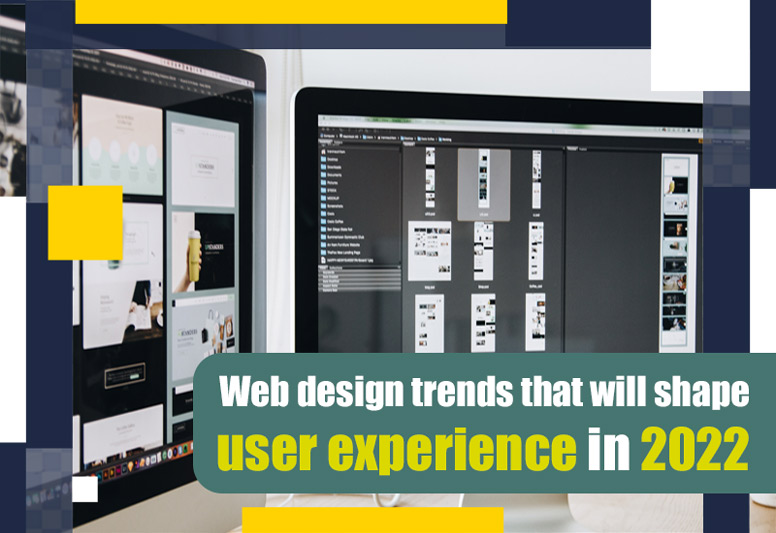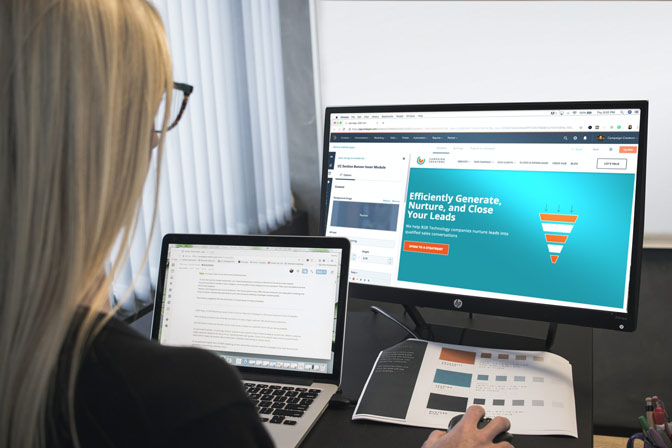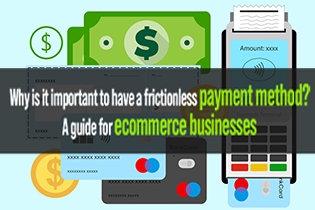
Web design has gone through numerous trends over the years. Certain features rise in popularity and then fade from the limelight, only to come back again just a few years later. You could almost say that design trends are cyclical and never really go out of fashion. However, with technological advancements, we are also witnessing some new design features that were previously unavailable to developers. In this article, we will go over 7 web design trends that will shape user experience in 2022.

1. AI everywhere
Machine learning and self-taught algorithms are spreading like wildfire. Businesses are looking to AI algorithms as a way to automate and streamline most of the processes relating to online sales. We can already see many websites adopting machine learning as a way to improve the user experience. Chatbots are already common, and they are currently primarily used to help users navigate websites and to offer sales assistance. In the future, we can expect to see AIs help create a personalized shopping experience for each website visitor based on their previous behavior. As the chat functions improve, AI-powered sales teams will be able to answer most user questions and guide them through their online purchase without the need for sales team members to step in personally.
2. Motion user interface
The current design philosophy for UI hasn’t really changed a lot recently. However, we have seen micro animations slowly gain momentum as dominant design trends that will shape user experience in 2022. Micro animations are being pioneered by eCommerce stores as a way to preview their products.
It turns out that online shoppers are less likely to purchase certain items based only on an image and a text description. This is particularly true for clothing and beauty items. Businesses were quick to catch on, and they responded to the needs of their users by creating product videos. Unfortunately, not every visitor opened video links, and auto-play features could slow down website performance. Enter micro animations – a functional and fast alternative for website videos.
Motion UI also has an important place in user engagement. Animated UI can help website visitors navigate pages by making context-sensitive buttons change shape and color. This can guide the user to the important navigational elements and have them change color and shape. Small animations are also welcome to engage the user while the page elements are loading up. However, it’s still recommended to adhere to the most important principles of traditional UI design. If you take things too far and add too many bells and whistles, users will probably be overwhelmed and have no idea what you want them to do or where they should click.

3. Minimalist design
Modern website design has adopted minimalist features, and simple, uncluttered websites are becoming widespread. Leaving empty white space on a website page is important because it lets the main content stand out. If the page is cluttered with multiple menus and call-to-action buttons, your website visitors will get confused and have difficulty navigating your site, leading to frustration and a negative user experience. Besides being easier to use, pages with a minimalist design are also faster to load, improving SEO and the overall user experience – making visitors more likely to return to your site.
4. Voice-activated features
Voice recognition software has made huge advancements in the last few years, and it’s definitely one of the most important web design trends that will shape user experience in 2022. Unfortunately, businesses need to optimize their entire web design for voice searches. Simply put, the syntax for voice search and navigation is different than for manually typed text. People express themselves in a more relaxed way when talking, and websites need to account for that in their design.

5. Increased engagement
If we were to rank web design trends by popularity, the number one spot would probably be taken by user engagement, and frankly – it’s been that way for a while now. Engagement is what search engines deem as the most important factor when ranking websites. Therefore, we can expect websites to try to foster more user engagement on their pages.
Engagement can be achieved by encouraging users to share content, firstly by producing quality content that users will want to share, and secondly by including widgets and other tools that enable single-button sharing. We can also expect to see more interactive features on pages since businesses have realized that user engagement is the key to boosting SEO. This will make polls, questionnaires, fill-out forms, and other features which were already present even more widespread.
6. Overhaul of visual elements
The importance of aesthetically pleasing design for websites cannot be understated. Naturally, users will spend more time on a website that looks pleasing and relaxing. This can be accomplished by using muted tones that don’t strain the eyes. Also, the careful use of layers and shadows can make important elements of the page stand out. Simple highlights can draw users' attention towards buttons and other navigational elements. Asymmetrical shapes and soft shadows are being used in place of complex visual features, which has the added benefit of making the website light and fast loading.

7. Customization
Centering web design on the needs of the users has become the norm. One of the best ways of catering to the individual needs of your website visitors is by letting them customize their experience on your site. This can be done through the use of dark themes, font selections, and scaling, as well as mobile and accessibility features. Visitors are bound to appreciate a user-first design.
The bottom line
Although web design occasionally takes giant leaps made possible by technological breakthroughs, for the most part, it's actually pretty easy to predict future trends. New technology takes a long time to become fully widespread and embraced by designers as well as users. This means that we are confident in our list of web design trends that will shape user experience in 2022. It's time to roll up your sleeves and redesign your website!








